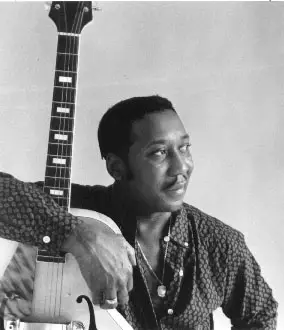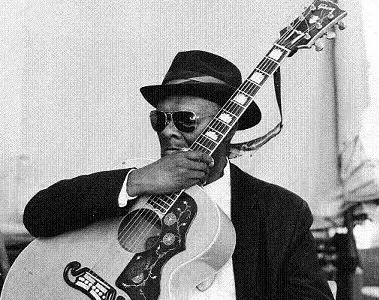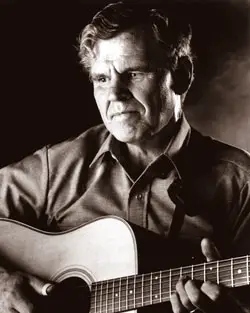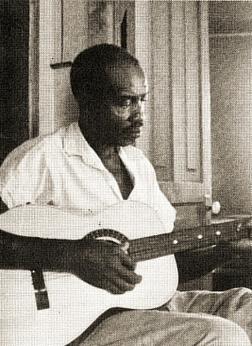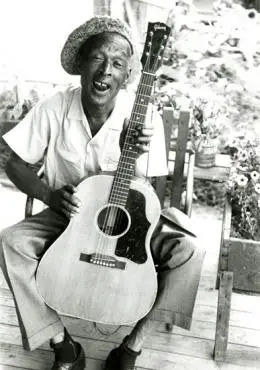
Jim Bruce Blues Guitar Lessons Click The Image To See Previews Jim Bruce Acoustic Blues Guitar Lessons A Complete Course - All Major Styles
The perfect format for learning the tricks used by the original blues men.
About Jim Bruce ... Want A Free Lesson? Get a complete FREE video lesson download (Love in Vain by Robert Johnson) |
|
|
In 1915, 17-year-old Broonzy was married and working his own land as a sharecropper.
He had decided to give up the fiddle and become a preacher. There is a
story that he was offered $50 and a new violin
if he would play four days at a local venue. Before he could respond to
the offer, his wife took the money and spent it, so he had to play. In
1916 his crop and stock were wiped out by drought.
Broonzy went to work locally until he was drafted into the Army in 1917. Broonzy served two years in Europe during the first world war. After his discharge from the Army in 1919, Broonzy returned to Pine Bluff, Arkansas where he is reported to have been called a racial epithet and told by a white man he knew before the war that he needed to "hurry up and get his soldier uniform off and put on some overalls." He immediately left Pine Bluff and moved to the Little Rock area but a year later in 1920 moved north to Chicago in search of opportunity.
At the start of the 1950s, Broonzy became part of a touring folk music revue formed by Win Stracke called I Come for to Sing, which also included Studs Terkel and Lawrence Lane. Terkel called him the key figure in this group. The group had some success thanks to the emerging folk revival movement. The exposure made it possible for Broonzy to tour Europe in 1951.
In Europe, Broonzy was greeted with standing ovations and critical praise wherever he played. The tour marked a turning point in his fortunes, and when he returned to the United States he was a featured act with many prominent folk artists such as Pete Seeger, Sonny Terry and Brownie McGhee, and Leadbelly. From 1953 on his financial position became more secure and he was able to live quite well on his music earnings. Broonzy returned to his solo folk-blues roots, and travelled and recorded extensively.
While in Holland, Broonzy met and fell in love with a Dutch girl, Pim van Isveldt. Together they had a child named Michael who still lives in Amsterdam.
In 1953, Dr. Vera (King) Morkovin and Studs Terkel took Broonzy to Circle Pines Center, a cooperative year-round camp in Hastings, Michigan, where he was employed as the summer camp cook. He worked there in the summer from '53-'56. On July 4, 1954, Pete Seeger travelled to Circle Pines and gave a concert with Bill on the farmhouse lawn, which was recorded by Seeger for the new fine arts radio station in Chicago, WFMT-FM.
In 1955, with the assistance of Belgian writer Yannick Bruynoghe, Broonzy published his autobiography, entitled Big Bill Blues. He toured worldwide to Africa, South America, the Pacific region and across Europe into early 1956. In 1957 Broonzy was one of the founding faculty members of the Old Town School of Folk Music. At the school's opening night on December 1, he taught a class "The Glory of Love".
By 1958 Broonzy was suffering from the effects of throat cancer. He died August 15, 1958, and is buried in Lincoln Cemetery, Blue Island, Illinois.
Click To See Previews Of My Acoustic Blues Guitar Course
Broonzy's own influences included the folk music, spirituals, work songs, ragtime music, hokum and country blues he heard growing up, and the styles of his contemporaries, including Jimmie Rodgers, Blind Blake, Son House, and Blind Lemon Jefferson. Broonzy combined all these influences into his own style of the blues that foreshadowed the post-war Chicago blues sound, later refined and popularized by artists such as Muddy Waters and Willie Dixon.
Although he had been a pioneer of the Chicago blues style and had employed electric instruments as early as 1942, his new, white audiences wanted to hear him playing his earliest songs accompanied only by his own acoustic guitar, since this was considered to be more "authentic".
A considerable part of his early ARC/CBS recordings have been reissued in anthology collections by CBS-Sony, and other earlier recordings have been collected on blues reissue labels, as have his later European and Chicago recordings of the 1950s. The Smithsonian's Folkways Records has also released several albums featuring Big Bill Broonzy.
In 1980, he was inducted into the first class of the Blues Hall of Fame along with 20 other of the world's greatest blues legends. In 2007, he was inducted into the first class of the Gennett Records Walk of Fame along with 11 other musical greats including Louis Armstrong, Jelly Roll Morton, Gene Autry, Lawrence Welk and others.
Broonzy as an acoustic guitar player, inspired Muddy Waters, Memphis Slim, Ray Davies, John Renbourn, Rory Gallagher, and Ben Taylor.
In Q Magazine (September 2007) it is reported that Ronnie Wood of The Rolling Stones claims that Bill Broonzy's track, "Guitar Shuffle", is his favorite guitar music. Wood said, "It was one of the first tracks I learnt to play, but even to this day I can't play it exactly right."
During the benediction at the 2009 inauguration ceremony of President Barack Obama, the civil rights leader Rev. Dr. Joseph Lowery paraphrased Broonzy's song "Black, Brown and White Blues". Broonzy recorded over 350 compositions.
In 1915, 17-year-old Broonzy was married and working his own land as a sharecropper. He had decided to give up the fiddle and become a preacher. There is a story that he was offered $50 and a new violin if he would play four days at a local venue. Before he could respond to the offer, his wife took the money and spent it, so he had to play. In 1916 his crop and stock were wiped out by drought.
Broonzy went to work locally until he was drafted into the Army in 1917. Broonzy served two years in Europe during the first world war. After his discharge from the Army in 1919, Broonzy returned to Pine Bluff, Arkansas where he is reported to have been called a racial epithet and told by a white man he knew before the war that he needed to "hurry up and get his soldier uniform off and put on some overalls." He immediately left Pine Bluff and moved to the Little Rock area but a year later in 1920 moved north to Chicago in search of opportunity.
At the start of the 1950s, Broonzy became part of a touring folk music revue formed by Win Stracke called I Come for to Sing, which also included Studs Terkel and Lawrence Lane. Terkel called him the key figure in this group. The group had some success thanks to the emerging folk revival movement. The exposure made it possible for Broonzy to tour Europe in 1951.
In Europe, Broonzy was greeted with standing ovations and critical praise wherever he played. The tour marked a turning point in his fortunes, and when he returned to the United States he was a featured act with many prominent folk artists such as Pete Seeger, Sonny Terry and Brownie McGhee, and Leadbelly. From 1953 on his financial position became more secure and he was able to live quite well on his music earnings. Broonzy returned to his solo folk-blues roots, and travelled and recorded extensively.
While in Holland, Broonzy met and fell in love with a Dutch girl, Pim van Isveldt. Together they had a child named Michael who still lives in Amsterdam.
In 1953, Dr. Vera (King) Morkovin and Studs Terkel took Broonzy to Circle Pines Center, a cooperative year-round camp in Hastings, Michigan, where he was employed as the summer camp cook. He worked there in the summer from '53-'56. On July 4, 1954, Pete Seeger travelled to Circle Pines and gave a concert with Bill on the farmhouse lawn, which was recorded by Seeger for the new fine arts radio station in Chicago, WFMT-FM.
In 1955, with the assistance of Belgian writer Yannick Bruynoghe, Broonzy published his autobiography, entitled Big Bill Blues. He toured worldwide to Africa, South America, the Pacific region and across Europe into early 1956. In 1957 Broonzy was one of the founding faculty members of the Old Town School of Folk Music. At the school's opening night on December 1, he taught a class "The Glory of Love".
By 1958 Broonzy was suffering from the effects of throat cancer. He died August 15, 1958, and is buried in Lincoln Cemetery, Blue Island, Illinois.
Click To See Previews Of My Acoustic Blues Guitar Course
Broonzy's own influences included the folk music, spirituals, work songs, ragtime music, hokum and country blues he heard growing up, and the styles of his contemporaries, including Jimmie Rodgers, Blind Blake, Son House, and Blind Lemon Jefferson. Broonzy combined all these influences into his own style of the blues that foreshadowed the post-war Chicago blues sound, later refined and popularized by artists such as Muddy Waters and Willie Dixon.
Although he had been a pioneer of the Chicago blues style and had employed electric instruments as early as 1942, his new, white audiences wanted to hear him playing his earliest songs accompanied only by his own acoustic guitar, since this was considered to be more "authentic".
A considerable part of his early ARC/CBS recordings have been reissued in anthology collections by CBS-Sony, and other earlier recordings have been collected on blues reissue labels, as have his later European and Chicago recordings of the 1950s. The Smithsonian's Folkways Records has also released several albums featuring Big Bill Broonzy.
In 1980, he was inducted into the first class of the Blues Hall of Fame along with 20 other of the world's greatest blues legends. In 2007, he was inducted into the first class of the Gennett Records Walk of Fame along with 11 other musical greats including Louis Armstrong, Jelly Roll Morton, Gene Autry, Lawrence Welk and others.
Broonzy as an acoustic guitar player, inspired Muddy Waters, Memphis Slim, Ray Davies, John Renbourn, Rory Gallagher, and Ben Taylor.
In Q Magazine (September 2007) it is reported that Ronnie Wood of The Rolling Stones claims that Bill Broonzy's track, "Guitar Shuffle", is his favorite guitar music. Wood said, "It was one of the first tracks I learnt to play, but even to this day I can't play it exactly right."
During the benediction at the 2009 inauguration ceremony of President Barack Obama, the civil rights leader Rev. Dr. Joseph Lowery paraphrased Broonzy's song "Black, Brown and White Blues". Broonzy recorded over 350 compositions.

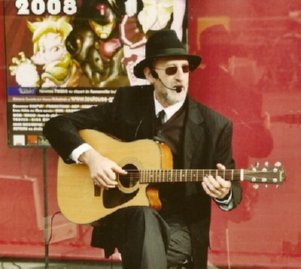
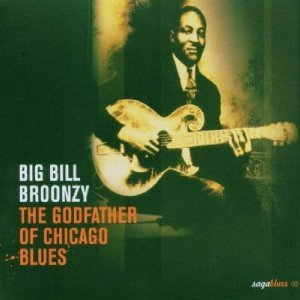 Through the ‘30s and ‘40s he
successfully navigated a transition in style to a more urban
blues guitar picking sound popular with white audiences.
Through the ‘30s and ‘40s he
successfully navigated a transition in style to a more urban
blues guitar picking sound popular with white audiences. 



